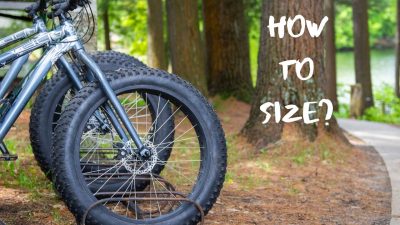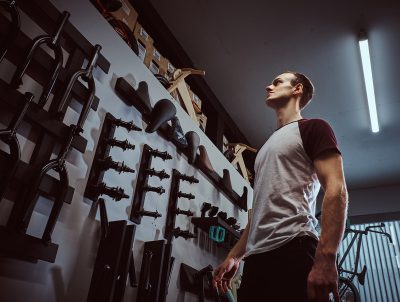Purchasing a fat bike can be an extremely exciting experience. There is nothing quite like getting a new bike to hit the trails and enjoy seeing different parts of the world.
A proper amount of research needs to be done before making a purchase since most fat bikes will end up costing over $1000. Finding just the right components, the right color, the right features and more are great, but don’t overlook one of the most important aspects of the shopping experience: sizing.
If a bike is not the right size, it’s never going to be a fun experience no matter how amazing the bike is otherwise. People will constantly be looking for a way to make adjustments that might work temporarily, but it just could lead to another adjustment down the road.
How exactly does sizing for a fat bike work? It’s very similar to sizing for a mountain bike, and while many encourage people to make some subtle changes for a truly customized fit, most will be able to ride a perfectly as soon as it is set up.
Below is a look at how a person can determine what size fat bike is best for them. It doesn’t take a ton of time to figure it out, especially since the majority of people will easily be able to narrow it down to two potential sizes early on. From there, how a person rides and personal preference can help make the final decision.
What Are the General Size Range For Fat Bikes?
First, it is important to note that every company is slightly different with their sizing. If a person is on the fringe of two sizes, it is recommended to go with a smaller option if a rider is fairly new. It ensures that the bike is not too overwhelming, and it is easier to add on then to takeoff.
Generally speaking, the size of fat bikes go off of height. This is the most commonly used chart across the board for fat bike sizes based on height.
- 4’10”-5’2” (148 cm-158 cm) = X-Small
- 5’2”-5’6” (158 cm-168 cm) = Small
- 5’6”-5’10” (168 cm- 178 cm) = Medium
- 5’11”-6’1” (178 cm-185 cm) = Large
- 6’1”-6’4” (185 cm-193 cm) = X-Large
- 6’4″ and above (193 cm and above) = XX-Large, or a customized option
Keep in mind that height is a good indicator, but it could change dramatically if a person has long arms or legs. This happens a lot with growing children, as they could be going through another growth spurt soon. If a child is still growing, sizing up might be a great solution.
The importance of Measuring the Inseam
A good amount of fat bikes have a pretty high bar that need straddled when a person is not peddling. If it is too big, it becomes a major hassle to come to stops and maneuver the bike in general.
Standover height should be about 2 to 5 inches less than the inseam. That way, a person can comfortably step on and off the bike when they are riding.
Generally speaking, height is proportional to leg and arm length. Occasionally though, that will not be the case. If someone has particularly long legs, measuring the inside of the leg is the better way to get an accurate fit. This could put a rider in a different size category than their height.
Common Fat Bike Sizing-Related Questions

Sizing can appear to be pretty complicated for some people, but the good news is that there is a wealth of information out there to help nail down a properly fitted bike.
How do I Adjust the Bike if the Sizing is Wrong?
If for one reason or another a person purchases the wrong sized bike, it’s not necessarily the end of the world. In fact, some people will find a way to make it work and not look back at all.
Adjustments are always available, even if it does cost a little bit of money in the end.
Adjust the Positioning of the Saddle
A saddle moves forward or backward on most bikes, and that will adjust the size a little. It’s very easy to move the saddle, and lock it in for the right fit.
Buy a Longer or Shorter Stem
Body position is huge on bikes, and adjusting it will make a bike feel bigger or smaller. A stem allows for more flexibility up and down, which can help change the size of a bike without getting a brand new frame.
Most of the time, buying a longer or shorter stem means also going to a bike shop to get it properly installed. This can be a little tricky to do if a person has never done it before.
Get a Longer Seat Post
Much like a longer stem, a longer seat post is going to help out as well. There is no reason to get a smaller seat post since there is already a setting to go all the way down. A longer seat post will prop a person up more, and give longer legs more room to extend and maximize performance peddling.
Patience
Some people might think they purchased the wrong size, but they are just adjusting to what should be their proper size. It might feel a little different first, but after proper sizing, don’t automatically assume that it was wrong because it doesn’t feel right from the very beginning.
Start out by riding on short trips to see if any adjustments need to be made. Start extending it more and more to see a difference. It might take a few rides to fully adjust, and even some initial ones in the beginning.
How Important is it to Try that Bikes Out in Person?
It has long been recommended that everyone should take the opportunity to try out a new fat bike at a local bike shop if possible. There’s nothing quite like test driving a new fat bike, especially if a person doesn’t quite know yet which option is best for them.
However, things are evolving quite a bit. Local bike shops are struggling to keep as many options in stock as there are available online. More people than ever are making purchases online, and then either assembling them at home, or taking them into a local shop. They reluctantly at times put them together for a fee, even though they ideally would love for people to make their initial purchase there.
With the accuracy of sizing in today’s world, most people feel pretty confident that they can order online without ever actually trying out a new bike. Some don’t have a choice if they can’t find a local shop that carries what they are purchasing. It doesn’t hurt to do some standard sizing on any type of bike at a shop, but don’t feel like it is impossible to make a purchase completely online.
How Should Handlebars Fit When Looking at Sizing?
It’s recommended to stay on the smaller side with a fat bike frame, but with handlebars, go the opposite way. Wider handlebars will allow for more freedom and hand positioning. If the handlebars are too narrow, it could feel uncomfortable during long rides.
Unlike road bikes where every single ounce matters, a fat bike won’t have noticeable weight difference by having wider handlebars. There are ways to make adjustments after purchasing, so don’t go too small in that category.
How Can a Person Realize if they Have the Right Saddle Height or Not?
For an efficient ride on any type of bike, picking the right saddle height is essential. If it is too low, a person won’t be getting an efficient pedal every single time. If it’s too high, the legs will have a lot of trouble peddling as well.
The goal is to have the knees slightly bent at the bottom of every single pedal stroke. Some people think that they need to be locking out at the bottom, but that is going to do damage in the long run. Aim for about 10 to 15 degrees with a bend in the knee for a great fit overall. If the saddle can’t adjust to that height, it might be a telltale sign that a different size as needed.
How important is Standover Height? Can’t a Person Just Lean to the Side to Dismount?
This is the most common way for people to do subtle additional checks to make sure that they have the right size for a fat bike. Most of the frames have a fairly high bar to stand over, and it’s a good test to see if there is proper clearance.
Aim for about 1 inch of clearance over a high bar. If a person can’t clear the entire bar, it’s going to be very uncomfortable to stop and start on the bike. It might seem easy to lean to the side, but all it takes is one sudden stop to see that is simply not the case.
Is it Easy to Make Component Changes to Make up for a Poorly Fitted Bike?

Unfortunately, a frame that doesn’t fit is going to be very hard to adjust, even with component changes. Some slight adjustments are possible, but it just is too much to overcome in most cases.
Some of the parts that make the most difference are going to be the saddle, the stem, and the handlebars. However, if the frame is just too big or too small, a rider is always just going to feel very, very cramped or too spread out in general.
Some people fall in love with certain upgrades, and it can help enhance the fit. If a person already owns a fat bike, using some of the components they love on the new bike might be a good way to make a decent fit into a great fit.
Do all Fat Bikes Fit the Same Way?
Remember that the fitting guide is only a rough estimate for any person out there shopping for a fat bike. Certain brands are notorious for being a little too small, or too big. To research a specific brand, search the name and size to see if anything pops up. More often than not, people online have already shared their thoughts on how certain bikes fit (as well as their general thoughts on the bike).
With all that being said, companies understand that a lot of fat bike shoppers might be purchasing a bike from the comfort of their home. Without having the ability to try it out, they strive to provide very standard sizing across-the-board. It benefits them because it means fewer negative reviews if a person purchases a bike, only to find that the sizing is completely off.
What Are the Negative Effects of Using a Bike that Doesn’t Fit Properly?
The average fat bike rider can spend at least an hour riding in one very specific position. If that position is not ideal, it could put a lot of stress and wear on a person’s body.
A poorly fitted bike can cause anything from back issues to severe arm fatigue. It might not be that noticeable during the ride, but the next day there could be a ton of pain and soreness. This is the easiest way to make people fall out of love with a fat bike if it causes too much pain.
From an efficiency perspective, riders will have a hard time keeping up with others even if they are in relatively the same shape. That is because while someone else is working with their bike, a person with a poorly fitted bike is fighting against their setup and overcompensating. Each pedal is not as efficient as it could be, and that starts to add up.
Finally, riding a poorly fitted bike is just not safe. It might be harder to break, harder to maintain speed, harder to stop and step off of the saddle, and more.
A lot of people don’t realize the importance of a properly fitted bike from a safety perspective, but it matters on any type of terrain. When going over tough trails covered in snow or unstable sand, it makes a huge difference.
Making the Effort for the Right Fit
At the end of the day, it’s not a huge hassle to try to find a fat bike that fits properly. After all, a person should be wanting that perfect fit, so they don’t have to worry about upgrading to a new option down the road.
It might be enticing to try to make a bigger or smaller bike work after finding a great deal or buying used from someone, but it will end up being more of a headache than anything.
When a person purchases a fat bike that doesn’t fit properly, it’s a constant battle to try to make several adjustments to make it work.
Remember, if for some reason a purchased bike online does not end up fitting as it should, reach out to the manufacturer and see if an exchange is possible. It might end up costing a little bit of money with shipping costs, but it is still worth the trade-off of having to deal with a subpar fit.
Every fat bike rider would agree that the experience is a lot more enjoyable when the bike fits as it should.

